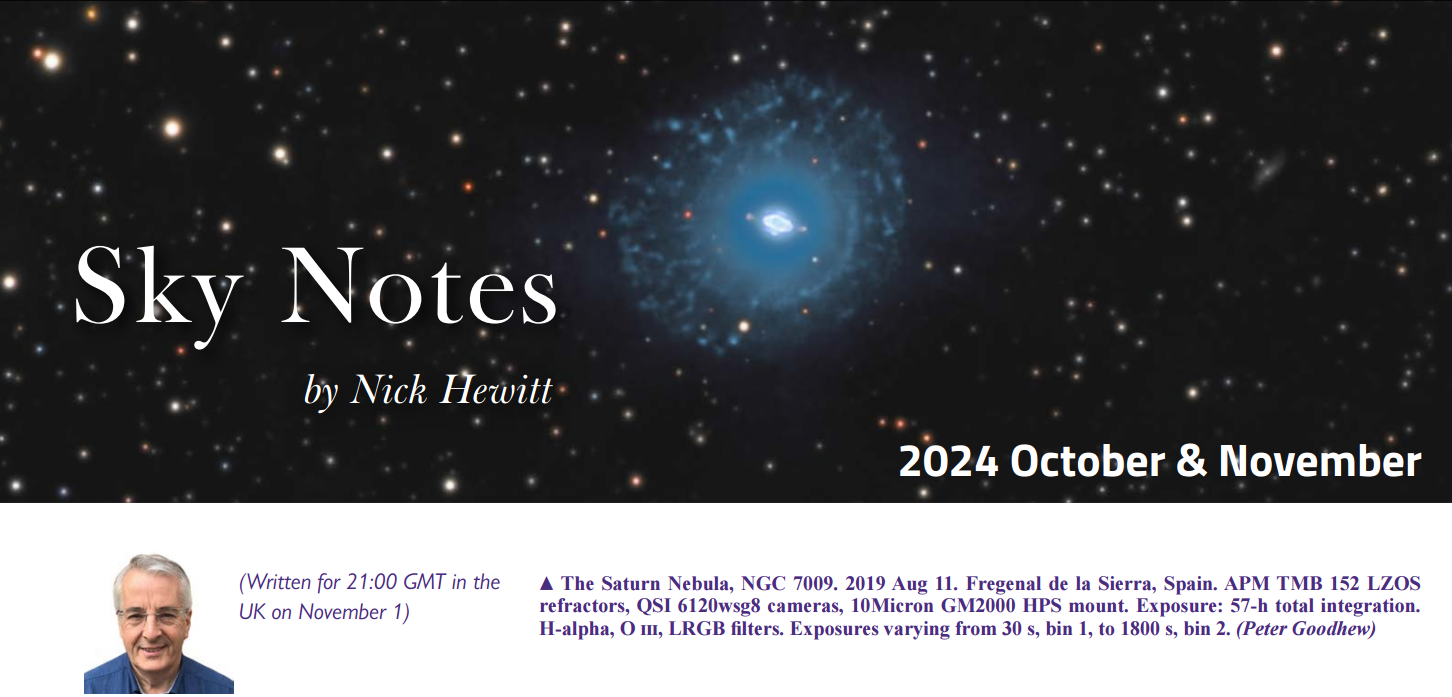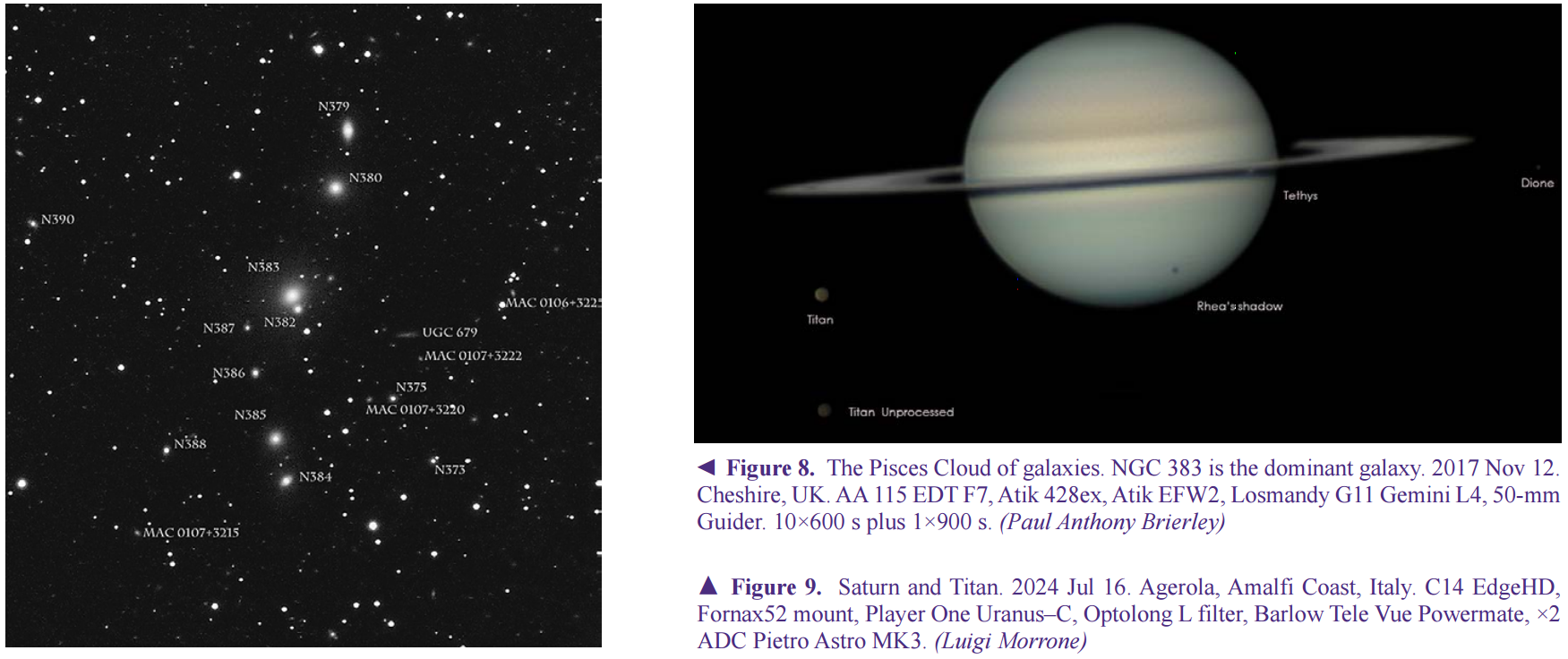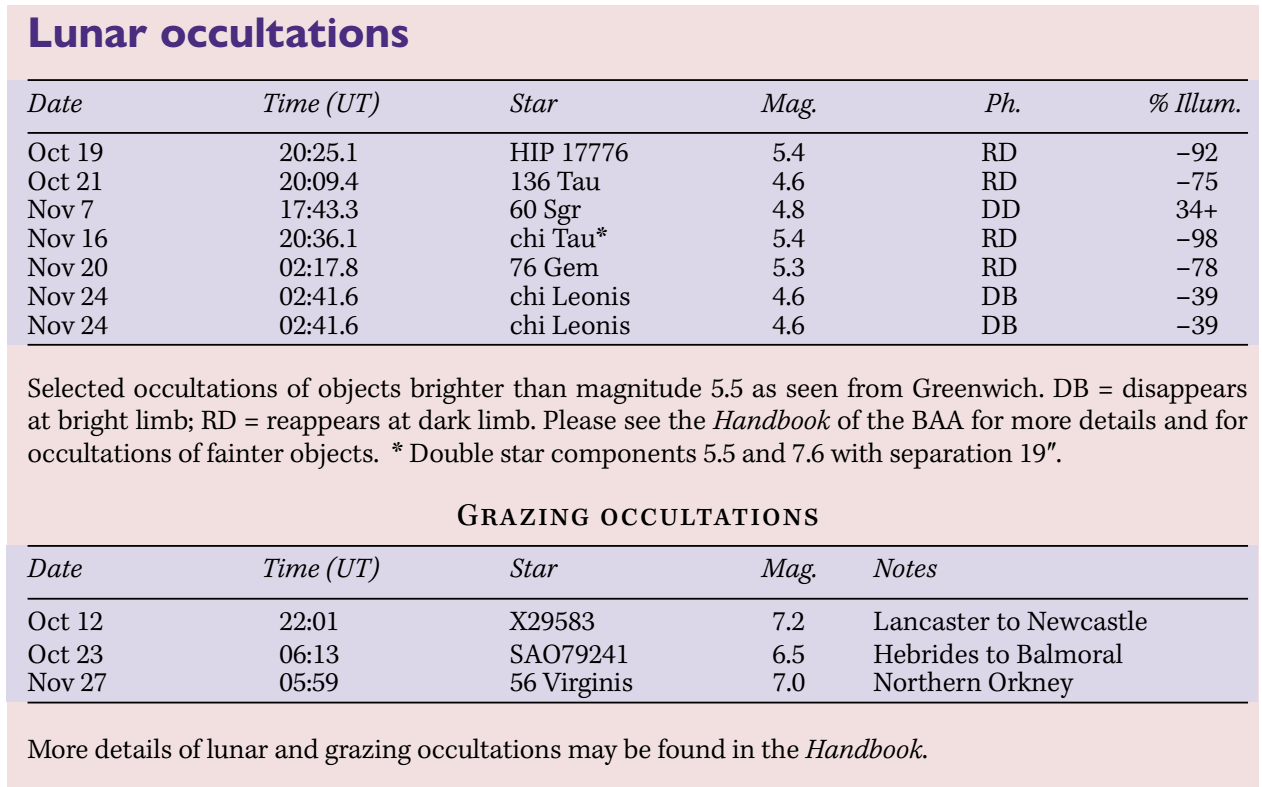Sky notes for 2024 October & November
2024 October 1

We have been starved of planets this spring and summer but now have a rich harvest throughout autumn. British Summer Time ends on Oct 27 and the darker evenings become perfect for viewing the outer members of our solar system.
The deep sky
The constellations of the autumnal sky are very watery, with fish and a water-carrier pursued by a whale. The Southern Fish, Pisces Austrinus, is obscure and often lost in the mists of the season, but it boasts Fomalhaut, the most southerly of the first-magnitude stars visible from the UK. It is magnitude 1.2 and quite isolated, found easily by following an imaginary line from Scheat (beta Pegasi) through Markab (alpha Pegasi), the western stars of our autumnal guide, Pegasus. Other than Fomalhaut, Pisces Austrinus is of little interest.
To its north lies Aquarius, the Water Carrier, slopping the contents of his burden into the waters inhabited by the Southern Fish. Aquarius is the 10th-largest constellation and a zodiacal, often seen accommodating the Moon or a planet. Indeed, this autumn, Saturn graces the aqueous cascade from the water jar on the eastern aspect of the constellation.

Aquarius contains three Messier objects: one good, one bad, and one downright daft. The easiest and best is Messier 2 (M2; Figure 1), a superb globular cluster that lies a fraction south of the celestial equator and four degrees due north of the brightest star in the constellation, Sadalsuud (magnitude 2.9). At magnitude 6.4, M2 is easy in finder telescopes and binoculars, and its generous 16-arcmin diameter gives a true dimension of 190 light-years if its current distance of 40,000 light-years is correct. Nevertheless, it is not easy to resolve, being Shapley Class II, the most concentrated of all Messier’s globular clusters. Larger apertures give a splendid view, with John Herschel describing it as ‘a heap of fine sand’.

In the western aspect of the constellation and just above Capricornus lies Albali (epsilon Aquarii), and two other entries from Messier’s catalogue: M72 and M73 (Figures 2 & 3). M72 is a rather poor globular cluster of magnitude 9.2 and just 6 arcmin in diameter. However, its looser central concentration, resulting in a designation of Shapley Class IX, makes it more easily resolved than M2. It is not spectacular, but worth a look. Immediately to its west is M73, which is not! It contains just four stars and no nebulosity, but despite being ‘extremely poor’ according to John Herschel, it was an entry in his General Catalogue and thence into the NGC! Find it once, then forget it.

To make up for the disappointment, slew northeast towards 4th-magnitude nu Aquarii and find the ‘other’ Saturn in Aquarius: the small, bright planetary nebula nicknamed ‘the Saturn Nebula’ (NGC 7009; Figure 4) because of its ansae that gave the impression of nearly edge-on rings when observed by Lord Rosse in the 1840s. The small, green oval is 45×35 arcsec and at magnitude 8, it has a high surface brightness and takes magnification well. Simple when observed visually with average amateur telescopes, its complexity is revealed when imaged using modern techniques (see above image).

A far more challenging planetary nebula, and probably the nearest of its type to us, is the Helix (NGC 7293; Figure 5). This large, low-surface-brightness object requires a pristine, moonless sky for visual observation. Despite its magnitude of 7.6, it is low in the sky, and its light is spread over an area similar to that of the full Moon. Imagers find it a most rewarding target, with fine detail obtainable.

While in Aquarius, locate the symbiotic star R Aquarii and its associated faint nebula, Cederblad 211 (Figure 6). Located somewhat southeast of Saturn this autumn, this variable, Mira-like star has a white-dwarf companion invisible to amateurs, the separation being just 55 milliarcseconds! The variability, of range 6.5–10.3, can be easily followed. Its predicted maximum around September or October will provide a good opportunity to find and estimate its magnitude. The nebula itself is a challenge for owners of large telescopes to take on, with hours of imaging needed. It was formed by past, nova-like outbursts.
Journeying northeast of Aquarius, we encounter more fish that also represent a zodiacal member: Pisces. Another large constellation (the 14th largest of the 88), it represents a pair of fish tethered by their tails to a line. The alpha star, Alrescha, forms the apex of the line and sits on the border with Cetus, the Whale. Now we can use Pegasus, the flying horse, as a guide to Pisces, a constellation that boasts no bright stars itself. The western end of Pisces lies beneath Pegasus and is easily made out thanks to the Circlet asterism. This is quite easily identified on a clear night, although difficult from urban environments as none of its components are brighter than 3.7. Once found, examine the easternmost star, 19 or TX Piscium, a notably red object especially in binoculars. It is a carbon star of spectral type C7 and varies irregularly, but not by that much, from 5.5 to 6.
Alrescha itself is a close double star of interest, with components of magnitude 4.1 and 5.1. Their current separation is 1.86 arcsec and has slowly diminished since its discovery by William Herschel in 1779. Measured in 1831 at a more manageable 3.6 arcsec, the orbit is thought to be as long as 3,267 years. Although both components are spectral type A (and both are spectroscopic binaries), the perception of their colour has varied widely amongst observers. Pale yellow, through tawny, and even blue, have been described. The common-motion pair zeta Piscium is a much easier proposition for average amateur telescopes, the components being magnitude 5.6 and 6.5, and widely separated by 23 arcsec, but again the colours vary depending on the observer.
A lone white dwarf inhabits Pisces, the third to be discovered after 40 Eridani and Sirius B. This is van Maanen’s Star, named after its Dutch-American discoverer, Adrian van Maanen, who received a bad press since his erroneous insistence on measured observation of external galaxies, as we now know them. However, he was a fine astrometrist when measuring stars in the Milky Way, and found this star had a high proper motion of 2.98 arcsec per year on photographic plates between 1914 and 1917. Now called van Maanen 2, it is the third-closest white dwarf to the solar system after Sirius B and Procyon B. It lies 2 degrees south of delta Piscium in a sparse area, the same low-power field as 6th-magnitude HIP 3765, and directly south of a 10th-magnitude star. It is magnitude 12.3 so can be glimpsed quite easily with a 200-mm telescope under a favourable sky. It is 14 light-years from us.

M74 is a well-known, face-on galaxy beloved of imagers, but other galaxies abound. NGC 520, the ‘flying ghost’ galaxy, is fun: an Arp galaxy (Arp 157; Figure 7) comprised of an 11th-magnitude colliding pair with faint, tidal tails. It was a William Herschel discovery in 1784, so well within the range of modern amateurs. More testing and definitely one for more advanced observers is the Pisces Galaxy Cloud (Figure 8). The main galaxy is the 12th-magnitude, lenticular NGC 383 that lies at the centre of a faint chain of ellipticals including NGCs 379, 380, 382, 386, and 387. Find the tip of the eastern fish (5th-magnitude omicron Piscium) and drift eastwards to the 6th-magnitude star 76 Piscium. A short hop further east will locate the Cloud.

The solar system


Moon & Sun
There is an annular eclipse of the Sun on Oct 2 although nothing will be visible from the UK. The path traverses great swathes of the Pacific Ocean and ends having crossed southern Chile and Argentina. Perhaps the most atmospheric views will be from Easter Island, from where a ‘Ring of Fire’ lasting some six minutes can be enjoyed.
Planets
The best planet on show is Saturn (Figure 9). Having passed opposition on Sept 8, it now inhabits Aquarius and thus is on the meridian mid-evening at the end of October. It has reached an altitude of 23 degrees, a marked improvement compared with recent years, so there is rather less atmosphere to distort the seeing. Its near edge-on ring system may diminish the beauty for some, but seeing both hemispheres allows for interesting comparisons, and transits and eclipses of the Saturnian moon system become available for a year or two.
Mercury was at superior conjunction on Sept 30 and remains unobservable through October. Although reaching greatest elongation on Nov 16, it is too low for evening viewing.
Although Venus is bright, it remains too low in the twilight for satisfactory viewing. Its southerly declination as it passes through Libra to Sagittarius makes this apparition disappointing.
Mars becomes a much more profitable target through these two months, moving eastwards from Gemini to Cancer but brightening from +0.4 to −0.4 and swelling from 7.6 to 11.6 arcsec. The north pole is tilted slightly towards us, but much of both hemispheres will be visible, and the Martian Vernal Equinox occurs on Nov 12 (the beginning of northern spring). The bright, small, southern polar cap should be seen, and the northern polar hood – as observed in late July – may have developed. As for large dust storms, we shall have to await developments (see the Mars Section blog at tinyurl.com/y35nca6b).
Jupiter reaches opposition on Dec 7 and blazes in Taurus at magnitude −2.8. With a high altitude, and a disc reaching 48 arcsec, detail should be staggering in good telescopes. The dance of the Galileans around their parent is endlessly fascinating, but Amalthea (Jupiter V) is a challenge at magnitude 14. It was discovered by E. E. Barnard on 1892 Sept 9: a visual discovery using the 36-in Lick refractor on Mt Hamilton, the last satellite to be discovered visually. Keeping Jupiter out of the field is the trick!
Uranus will be at opposition on Nov 17, with a small retrograde on the Taurus-Aries border as autumn gives way to winter. It is a binocular object at magnitude 5.6 and subtends a disc of 3.8 arcsec. The moons are scattered around the disc and although faint, quite easily imaged with modern equipment.
Neptune is now past its opposition on Sept 21, and reasonably placed in Pisces. A small telescope should be enough to spot the magnitude-7.8, bluish disc as it retrogrades a short distance north of 24 Piscium until resuming prograde in December.
Dwarf planet Eris may be a target for enthusiasts of trans-Neptunian objects when reaching opposition on Oct 18. At magnitude 18.6, it is within the range of imagers. It is in Cetus, but a short hop southwest from alpha Piscium.
Meteors
This period is a mixed bag for meteor enthusiasts, with the northern Taurids and Orionids suffering lunar interference, although the southern Taurids and Camelopardalids are more favourable.
The Moon is just past new when the Camelopardalids peak on Oct 6, so it is not a nuisance. The shower can spring surprises, being notably active in 2005, 2006, and 2016. The radiant is close to Polaris and the shower, associated with the short-period comet 209P/Linear, could be well worth watching.
The Draconids peak during the evening of Oct 8, when the Moon is a waxing crescent so should not interfere. The shower derives from comet 21P/Giacobini–Zinner and is generally weak, but occasionally puts on a good display. The radiant is in the head of the Dragon, thus high up in the northwest by mid-evening.
The Southern and Northern Taurids should be well placed. The Southern Taurid maximum is on Nov 5 when the Moon is again a waxing crescent; the Northern Taurids peak a week later, with the Moon nearly full, so are much less favourable. Both showers have wide ranges of activity between mid-September and early December: the Southern stream is swift, often with persistent trains; the Northern is slower and easily distinguishable, although both radiants are near the Hyades star cluster.
A bright, waning Moon compromises the Orionids’ peak on the night of Oct 21–22, but their maximum is broad. These speedy meteors derive from comet 1P/Halley.
It is 25 years since the marvellous Leonid display of 1999 Nov. We shall have to wait a further eight years before the next potential storm of this shower, which has a 33-year cycle. It peaks on Nov 18, but the Moon in a waning gibbous phase will be a nuisance. The shower is derived from comet 55P/Tempel–Tuttle.
Comets
Will C/2023 A3 Tsuchinshan–ATLAS perform post-perihelion? This much-anticipated object was reported in 2023 Jan in China and in 2023 Feb by the Asteroid Terrestrial-impact Last Alert System (ATLAS), hence the dual name. A potentially fine sight was anticipated for 2024 autumn after perihelion on Sept 27. Much imaging throughout the spring and summer has shown it behaving steadily, if far from spectacularly, so far. How it will appear once warmed by the Sun is unknown, but observing it from mid-October onwards could be memorable. On Oct 13, it will be a low, western, early-evening object in eastern Virgo, after which it rises in altitude while transiting quite rapidly through Serpens Caput and then Ophiuchus, probably fading as it goes.
| The British Astronomical Association supports amateur astronomers around the UK and the rest of the world. Find out more about the BAA or join us. |
